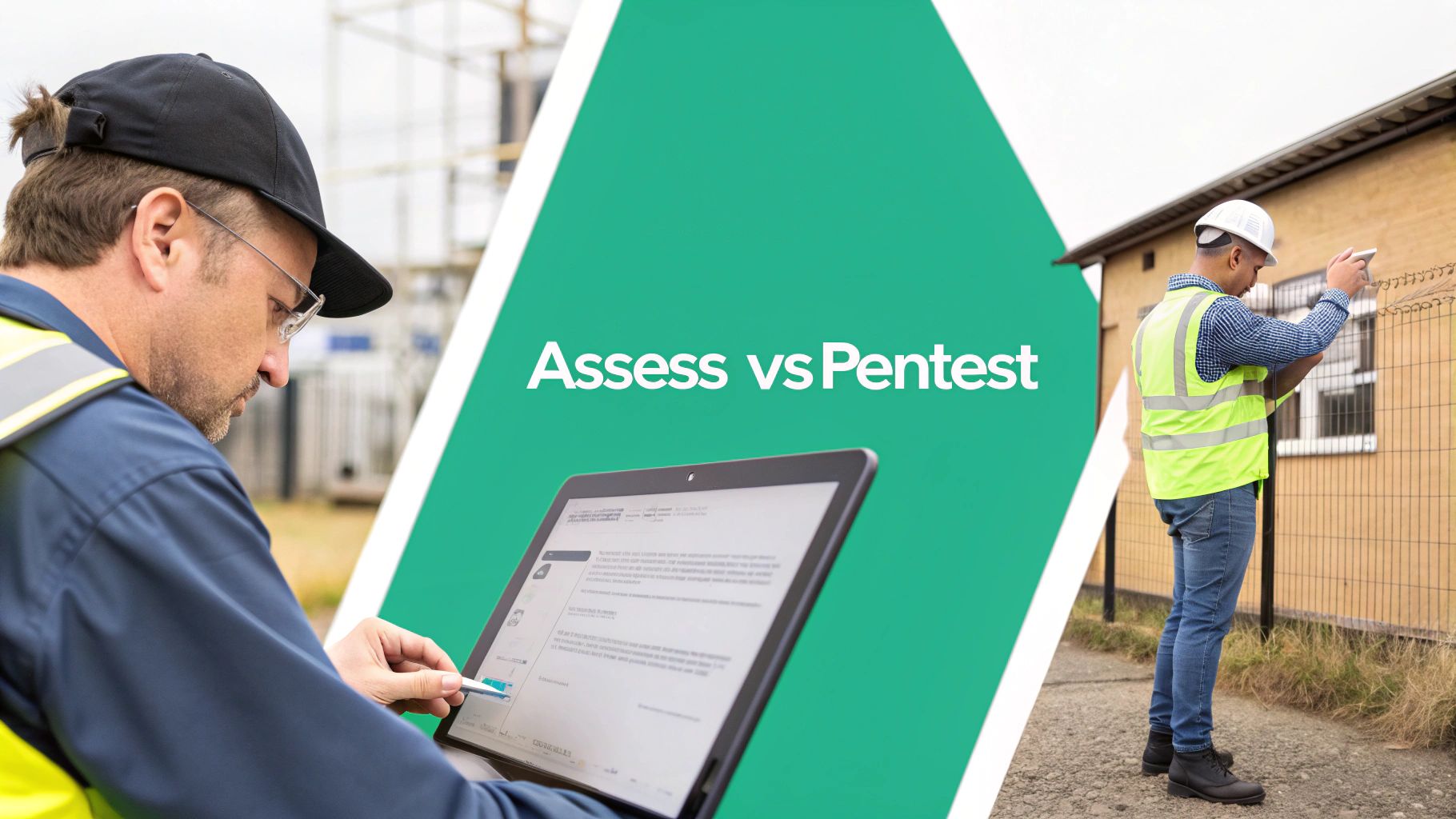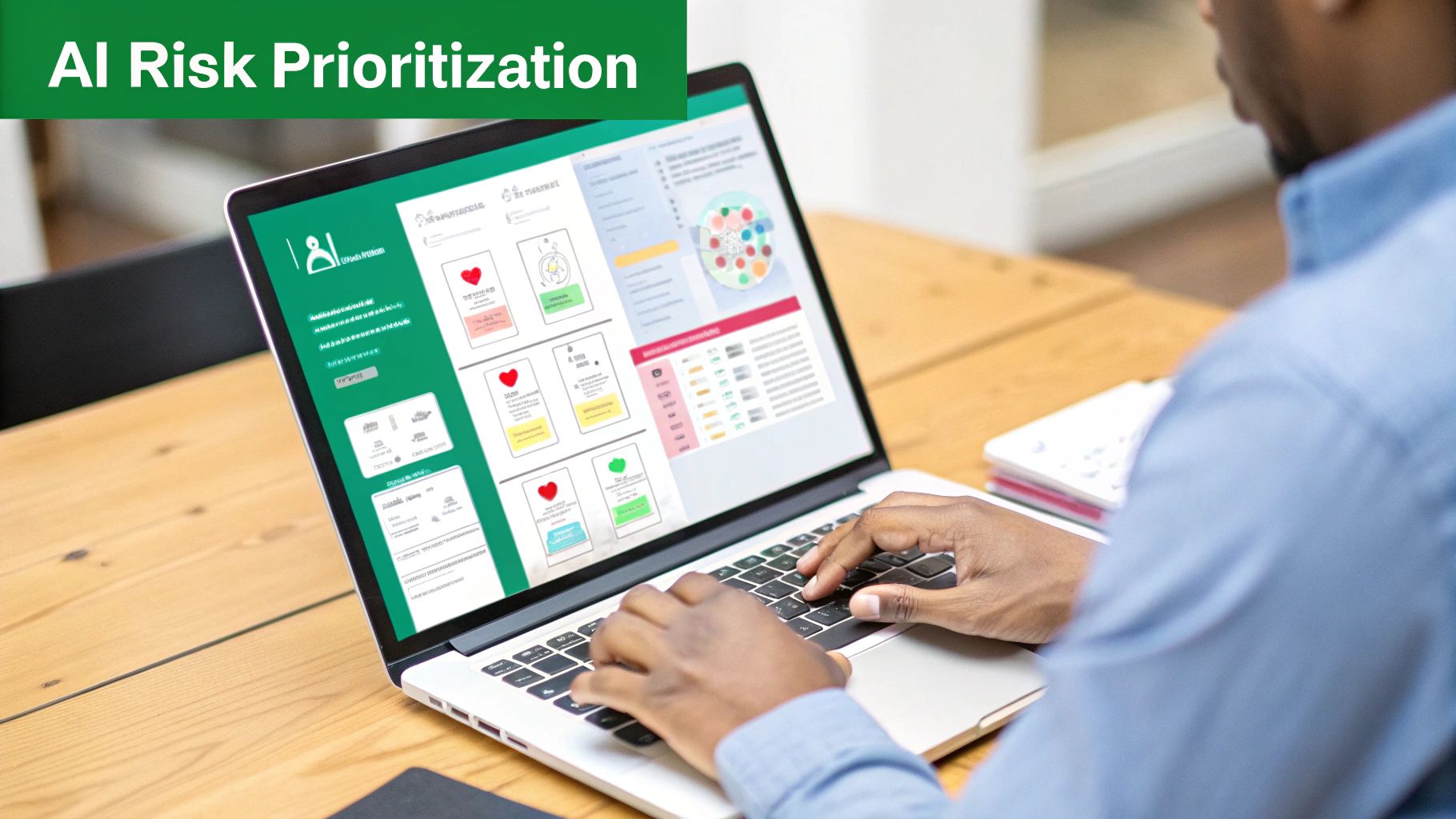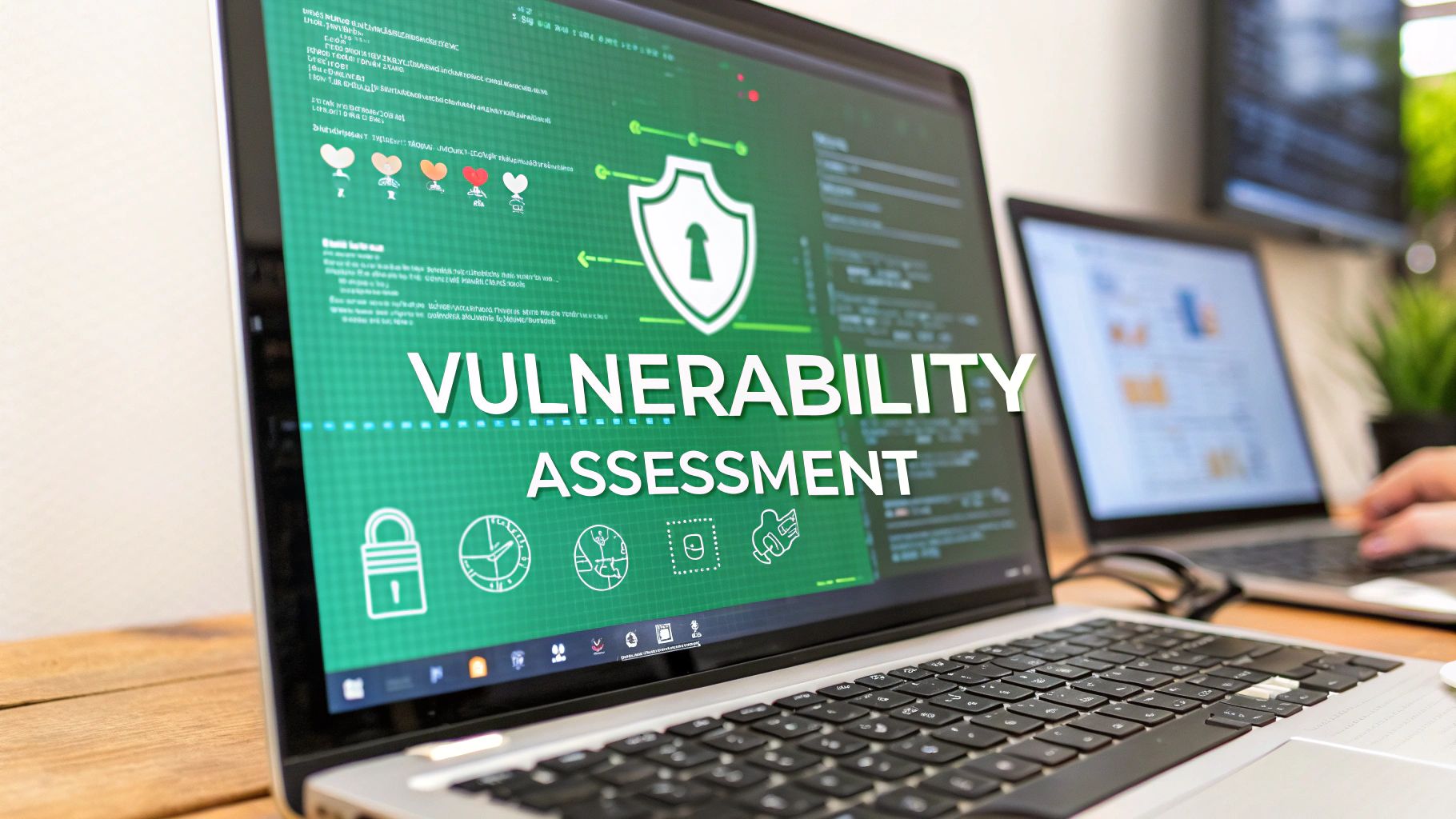A vulnerability assessment is a security checkup for your digital assets. Think of it like a building inspector checking every window and door for a weak lock before a burglar shows up. They don't break in; they just give you a list of what needs fixing. At Affordable Penetration Testing, we deliver these security roadmaps in days, not weeks.
This process scans your systems for known security weaknesses, giving you a clear report on what to patch. It’s a must-have first step for meeting compliance standards like SOC 2 and HIPAA, and we make it fast and affordable.
What Is A Vulnerability Assessment

A vulnerability assessment is a security checkup. It uses automated tools to scan your networks, servers, and applications for security flaws. The goal isn't to exploit these flaws but to create a complete list of potential entry points an attacker might use.
This process is great at finding common problems quickly. Things like unpatched software, weak server settings, or old security protocols are flagged right away. This is a key part of any SOC 2 penetration testing program.
The result is a prioritized report. It tells your IT team exactly what the weaknesses are and which ones pose the biggest threat. For any business needing a quick security audit, this provides an immediate action plan. Our fast penetration testing delivers these reports in as little as 48 hours.
The Four Phases Of A Vulnerability Assessment
A vulnerability assessment is not a straightforward process. We break it down into four phases to get you from discovery to a stronger defense as fast as possible.
We first define the scope of the assessment. Is this a table top exercise or will this include actual pentesting. We work with you to identify the critical systems and applications that need to be checked. This ensures we focus our efforts where they matter most.
Next, we go over the what if. After doing an inventory and scope of your network and/or system we run through a threat simulation.
Our OSCP and CEH certified experts analyze the network hunting for weaknesses. We filter out the false positives and analyze the real vulnerabilities to understand their business impact. And give you guidance how to mitigate this risk. This human step turns raw data into a clear plan.
Finally, we deliver a simple report. Forget 100-page documents full of jargon. We give you a prioritized list of what to fix and how to fix it, starting with the most critical issues.
Vulnerability Assessment Vs Penetration Testing

People mix these up all the time, but the difference is simple. A vulnerability assessment finds and lists potential problems. A penetration test (or pentest) tries to exploit those problems to see if a real attacker could get in.
Think of it this way. An assessment gives you a list of all unlocked doors and windows in your building. A pentest has an expert actually try to open those doors and climb through the windows. The assessment is a list; the pentest is a real-world attack simulation.
An assessment is broad and automated, covering a lot of ground quickly. A pentest is narrow and manual, with a human expert focusing on specific targets. For compliance like SOC 2 pentesting, you often need both. To dig deeper, check out our guide on vulnerability assessment vs. penetration testing.
Why You Absolutely Need These Security Assessments
Vulnerability assessments are not just a technical checkbox; they are a business necessity. If you need to meet compliance standards like SOC 2, HIPAA, or ISO 27001, these assessments are non-negotiable. They provide the evidence auditors need, saving you from painful audits and potential fines.
Finding a security weakness before an attacker does is thousands of times cheaper than a data breach. A proactive security posture shows customers you care about protecting their data. The vulnerability management market is growing because businesses realize finding and fixing weaknesses is essential for survival. You can see more on this growing market and its impact on Businesswire.
Regular assessments turn security from a reactive firefight into a manageable process. This is the core of smart security. To learn how to build this into your routine, see our guide on vulnerability management best practices.
How Modern Tech Makes Assessments Better And Faster

Vulnerability assessments are smarter than ever. Modern platforms use artificial intelligence (AI) to find complex threats that old scanners would miss. They also prioritize vulnerabilities based on real-world exploitability, not just a technical score.
This new approach is called risk-based vulnerability management. The market for these tools is growing fast because businesses are tired of chasing every minor alert. They want to fix what actually puts them at risk. Learn more about how AI is transforming vulnerability assessment on Reportprime.
This means your team can stop drowning in low-risk alerts and start fixing the issues that matter. It saves a lot of time and money. For a closer look at these tools, check our guide on automated penetration testing tools.
Ready To Get Your Security Assessment Started
Tired of high prices and long waits from traditional security firms? We deliver clear, actionable reports from certified professionals (OSCP, CEH, CREST) with transparent, upfront pricing. Our penetration testing pricing starts at just $4,999, and we deliver reports in days, not weeks. We are the affordable alternative.
Our affordable penetration testing gives you a prioritized roadmap that fits your budget and timeline. For MSPs and vCISOs, our services integrate seamlessly into your client offerings. Learn more at msppentesting.com. A good assessment gives you a clear plan. We deliver it fast and at a price that makes sense.
Stop wondering about your security. If you need an urgent penetration testing solution, fill out our contact form for a fast, straightforward quote. Let's get you the answers you need for your next security audit or compliance deadline, quickly and affordably.
Common Questions About Vulnerability Assessments
Let's clear up a few common questions about vulnerability assessments.
How Often Should We Run A Vulnerability Assessment
For compliance frameworks like SOC 2, quarterly assessments are the baseline. You should also run a scan anytime you make a significant change to your systems or applications. This quick check ensures you haven't introduced a new weakness during an update.
What Is The Difference Between Internal And External Assessments
An external assessment scans your systems from the public internet, just like an outside attacker would. It looks for weaknesses that anyone could see. An internal assessment is run from inside your network. This shows what a rogue employee or malware that’s already inside could do.
Can This Help With Our SOC 2 Compliance
Yes, it's essential. Regular vulnerability scanning is a core requirement for passing a SOC 2 audit. Our reports give auditors the exact proof they need to see you're proactively finding and fixing security risks. With thousands of new vulnerabilities disclosed each year, this is non-negotiable. You can learn more about these cybersecurity trends and market insights.
At Affordable Pentesting, we deliver the clear, actionable reports you need to stay secure and compliant without the typical high costs. Our pentest pricing is designed for businesses that need real security without breaking the bank.
Ready for a straightforward quote? Reach out through our contact form.
.svg)
